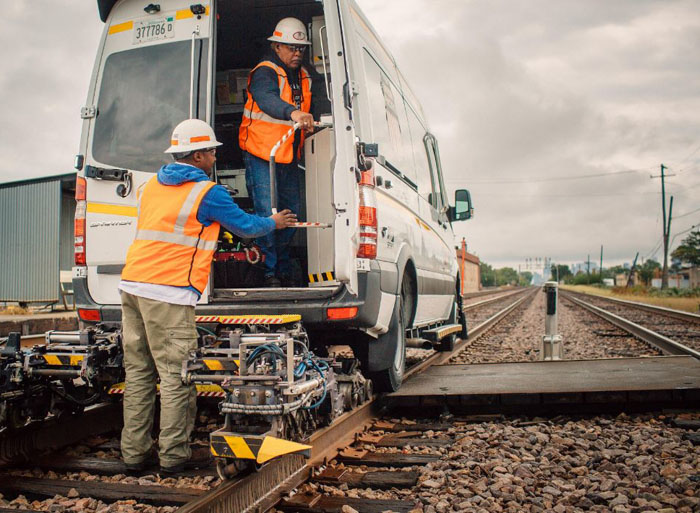Helping with this project
This hobby needs your help and EVERY certificate collector has something to offer.

My catalog and this website are dedicated entirely to collectors. My goal is to help keep the collecting of railroad stocks and bonds FUN. I firmly believe that every collector can contribute to the hobby. I guarantee that you have something to contribute. Join my impossible quest of cataloging every certificate that involved railroading in North America. The cold hard truth is that I need your help. I cannot possibly do this alone because:
- The hobby is too diverse.
- I will not live long enough.
- I do not have enough money.
- It would not be any fun.
Remember...
I am not doing this project for myself. I run this project to helping the hobby and to help collectors. If users derive please and information from this site, the owe a general debt not to me, but to the pioneers of the hobby. I am merely one person standing on the shoulders of giants. Yes, this site gives more information about railroad certificates than any other source. Still, the people who are mainly responsible for continuance of this project over twenty five years are collectors and dealers who contribute time sending scans and photographs of certificates they own. I hope you will consider tradition,
Below are the various ways you can contribute. I will pre-apologize if any suggestions seem too restrictive. Those are specific instances I have learned are necessary either save time entering information or explaining why I must limit this project in specific ways.
The best place to start
There are many ways you can help. You can start by spending a few minutes looking at Information Recorded. That page will give you a quick rundown on the types of information I seek.
Certificates or other information I have missed
Most collectors have one or more unlisted certificates or variations. Even if they don't, they certainly have unrecorded serial numbers and dates.
Start by examining your most common certificates. Compare your certificates with my listings. You might find a feature I missed. I often lack images of very common certificates. Information amout common certificates is the least contributed category.
I genuinely hope you will provide images. I want to record information about your certificates and the fastest and easiest way is to send iimages. no matter how common certificates may seem.
Be alert for undiscovered varieties among cataloged certificates. You know who finds the greatest number of undocumented variations? Beginners. It is normal for long-time collectors to overlook small variations; they have been in the hobby so long, they have seen some certificates hundreds, if not thousands of times. It is incredibly easy to overlook small features on common certificates. And it is true that not all small variations qualify for listing. Still, why not ask?
Scanned images of certificates

Scans are the single best way to help. It is ironic that only a few years ago, scanners had dropped greatly in price, all the while their quality had increased. But that was the exact time that smartphones became common and their cameras were growing in ever-increasing quality and function. Nonethless, because scanners reproduce without distortion, their images are still greatly superior to any other method.
Small scanners work perfectly well. Simply scan your certificates in two or more overlapping pieces. Orientation does not matter, although it is better if you try to keep the tops of successive scans pointing in the same direction. Try to get AT LEAST 1.5 inches of overlap between scans. Don't try to patch images together. Simply send me the pieces.
Here is what to do when making and sending scans of certificates:
- scan certificates at 300 dpi
- scan important autographs at 600 dpi
- scan large certificates in two or more pieces with AT LEAST 1.5" overlap
- send images as ordinary email attachments
- send up to 30 MB of images in a single email (no need to zip)
- turn off auto exposure (if your software allows)
- scan certificates against VERY light blue, light gray, or white backgrounds
- save as medium-high quality JPGs (not the highest)
- TIFs, BMPs, PNGs, and GIFs are acceptable; I will convert
Here is what to avoid when making and sending scans of certificates:
- do NOT scan backs
- do NOT scan stubs
- do NOT scan coupons
- do NOT reduce images
- do NOT scan certificates against colored backgrounds
- do not fold stubs under certificates when scanning
- no need to "zip" single images
- no need to identify catalog numbers
- PLEASE, P:LEASE, PLEASE do NOT embed images in emails
- PLEASE do NOT embed images in PDFs, Excel, or Word files (they decrease quality)
There are several tricks to scanning certificates. The very thin lines in vignettes confuse auto exposure. You will get better scans by turning auto exposure off. I have a number of tips in a special section of this website dedicated to scanning certificates.
How much is 30MB (mgabytes)? That would about to roughly 8 or 9 stock certificates or 6 or 7 bonds scanned at 300 dpi and saved at 75% quality. The higher the quality and the higher the dpi, the fewer certificates to attach to one email. Just send more emails. No need to send one scan by email unless it's easier for you.
Photographed images of certificates
Photos are the second best way to send images. I greatly appreciate all photos sent to contribute information about descriptions, serial numbers, and dates. Smartphone cameras are quick, handy, easy, and perfectly acceptable for that purpose.
HOWEVER, while usable for contributing information, photographs are rarely usable for website displays. Unless professionally shot, almost all photographs suffer from problems that contributors don't initially notice. I have long experience at removing non-rectangular distortion. However, unequal lighting, shodows, poor focus, color shifts, and glare are usually beyond my abilities to fix.
How can you know if a photograph might be usable for display? Look at the exposure and colors between different parts of your certificste image. Compare opposite corners of your photo (i.e. compare bottom left to upper right and bottom right to upper left). If color, focus, and exposure is nearly equal, the photograph is probably sufficient for display. Nine out of ten times, unequal color and exposure are deal-killers.
Here is what to do when making photographs of certificates:
- take certificates out of holders
- photograph certificates against uniform-colored surfaces (light gray posterboard is good)
- shoot straight down on them (the more rectangular certificates appear in photos, the better)
- make sure serial numbers and dates are in focus
- if your certificate is too curled, flatten with weights (flat items like coins and rulers work best)
Here is what to avoid when making photographs of certificates:
- you do NOT need to identify catalog numbers
- you do NOT need to put anything in your photographs for scale
- you do NOT need to photograph backs, stubs, or coupons
Photocopied images of certificates
At one time, I received the majority of information via photocopies (Xerox, etc.). They remain perfectly adequate.
Here is what to do when making photocopies of certificates:
- reduce certificates to fit on 8-1/2 by 11 paper
- copy in pieces if necessary
- either black and white or color copies are okay
- make a note at the bottom about the "real" color of your certificate
Here is what to avoid when making photocopies of certificates:
- no need to report sizes
- no need to copy backs, stubs, or coupons
Information found elsewhere
Please send images and information only about certificates you own.
I ask you to AVOID SENDING IMAGES CAPTURED FROM EBAY, dealer websites, or collector websites. There are simply too many certificates out there. If I recorded every image like that, we would have a nice database and I would have no life.
Information in spreadsheet form
I appreciate your offer, but I BEG you,
PLEASE DO NOT SEND SPREADSHEETS of your certificate inventory.
Spreadsheets prevent me from:
- confirming accurate identifications
- spotting new varieties
- reviewing images in the future
Spreadsheets also:
- contribute less information than images
- require RADICALLY MORE TIME to record than images.
Links to images or information on the web
Again, I appreciate your thinking of me. but I ask contributors,
PLEASE DO NOT SEND LINKS to :
- items for sale on eBay or elsewhere
- dealer sites
- private collector sites
I already acquire information about certificates that sell on eBay for $20 and higher. I really appreciate your thinking of me and taking time to contribute. The real issue is the staggering amount of time collecting that type of infomration takes to procure and record.
Price guidance
I greatly appreciate price guidance for any items you are willing to tell me about.
What I am REALLY asking of you is the price YOU would be willing to pay to reacquire a certificate if something happened to YOUR certificate. I do not guesses of what some other unknown person might pay.
Your impression of potential value is flexible. You might be willing to pay significantly more today than you originally paid. Conversely, you might like to re-acquire a similar certificate again, but at a lower price. Sometimes. you might not want to replace your certificate at all. You might even be glad the certificate is gone. REAL PRICE GUIDANCE is what you would readily pay if something happened to a certificate in your possession.
Why would I like information like this? Because prices reflect desire, not rarity. A certificate might be truly rare, but there is little value if few people want it. Quantifying legitimate value is the goal.
Certificate prices
If and when you send information or images of certificates in your collection, I will greatly appreciate learning how much you paid. Prices in guidebooks and on dealer websites are fine, but globally inaccurate. Your purchases are REAL.
When asking about prices paid, I am looking for the entire amount paid for certificates including commission, BEFORE SHIPPING COSTS. Please include VAT (Value Added Tax) if pertinent, but not local sales taxes. Round prices to the nearest dollar. I do NOT need to know where you purchased.
Inspections and corrections

Union Pacific Railroad inspection crew
There are several million words on this website. There ARE mistakes! That means I REALLY need your help finding them. I really need to know about any mistakes you find or anything that doesn't make sense. The sooner you report, the faster I can fix.
Information about questionable companies
If you enjoy corporate research, and want problems to chew on, see my special page on Mystery companies.
Information about railroad companies
Many of you are incredibly serious about railroading. And many of you discover very obscure facts about companies.
I find that kind of info, also. HOWEVER, my goal is to catalog certificates from every railroad or coal company that operated or intended to operate in North America. People with a lot more knowledge than me record tremendous amounts of information about railroads in books, magazines, and on the web. For that reason, I do not record every morsel of information that comes my way.
I seek and keep information about railroad companies when that information directly involves the understanding or interpretation of certificates. I always appreciate additional information such as:
- states of incorporation
- dates of incorporation
- dates of dissolution
- nicknames (official or unofficial)
I record names of presidents, chief executive officers, and chairmen of boards when I learn their full spans of their service to the nearest year (no need for month and day). I do not record officer names until I learn starting and ending dates of their service.
I stress that this site is about collectible stocks and bonds. Information about track alignments, accidents, secondary personalities, passenger trains, corporate takeovers, and intricate financing is far beyond the scope of this website. Yes, I agree that kind of information is FUN. I am always researching something. Realistically, people seeking hard-core information about railroading and railroad companies are going to find better information elsewhere. Think about this project as providing ground-level information about certificates. Any other information about railroading must be a "30,000-foot view."